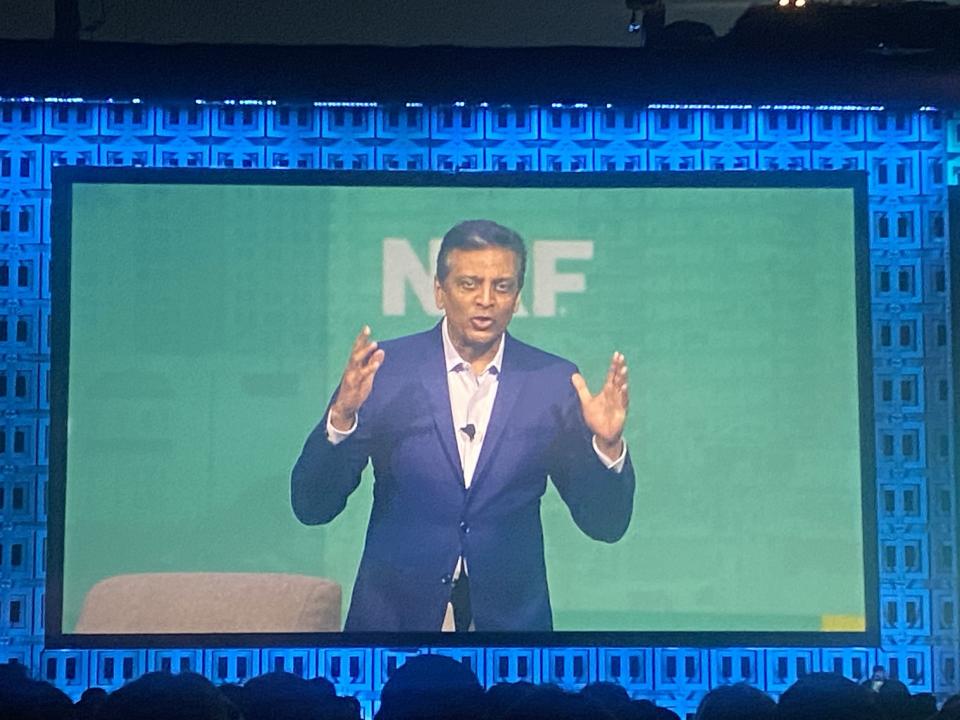FedEx CEO: ‘We Haven’t Seen Much’ Red Sea Impact
- Oops!Something went wrong.Please try again later.

The ongoing Houthi militia attacks in the Red Sea haven’t appeared to have an impact on FedEx just yet, according to CEO Raj Subramaniam.
In a fireside chat Sunday at the National Retail Federation (NRF) Big Show, Subramaniam said the effects of the mass diversions of vessels haven’t been felt across the business as the logistics giant already wrestles with a period of weak demand.
More from Sourcing Journal
“Well, the ocean represents about 90 percent of the total pounds that are moved or transported, and air freight represents about 10 percent, so even a small change in the ocean will ultimately have an impact,” said Subramaniam. “We haven’t seen much yet.”
“I don’t think it’s quite like the issue we saw in the pandemic, because there’s another way out, even though it’s a longer route,” Subramaniam said. “This is something we watch every single day…but it’s been a very challenging environment for the ocean operators in this situation.”

Subramaniam acknowledged the rise of ocean freight rates since the Houthi drone attacks began in November, while noting that air freight rates remain “very stable” right now.
When CNBC’s Squawk on the Street co-anchor Sara Eisen prodded Subramaniam on whether the air freight rates were headed “lower or higher,” the CEO said “it’s where we expected them to be.”
“Air demand and air freight rates are about the same level as they were before the [Red Sea] issue,” said Subramaniam.
Average worldwide air freight rates dropped by roughly 2 percent in the first week of 2024, according to the latest market data from WorldACD. German logistics giant DB Schenker expects any impact on of the attacks on these rates will happen in two-to-three weeks, with the company telling Reuters it has secured additional air freight space when the expected switch from ocean to air freight takes place.
The NRF conversation came a day after the Federal Maritime Commission (FMC) announced it would hold an informal public hearing on Feb. 7 to examine how conditions in the Red Sea and Gulf of Aden are impacting commercial shipping and global supply chains.
Ahead of the fireside chat, Subramaniam unveiled FedEx’s newest platform, Fdx, which is designed to enable users to make strategic logistics decisions from the point of demand, all the way through fulfillment, delivery and returns.
The all-in-one platform is expected to be launched to general audiences in fall 2024, and is currently available in a “private preview” mode for select brands on request.
The solution combines existing standalone features such as access to the ShopRunner e-commerce platform; the ability to share estimated delivery dates on product pages, in cart and at checkout; access to detailed carbon emissions data; and returns management.
Additionally, upon the fall launch, Fdx will also enable brands to integrate real-time FedEx network insights into their order management systems, which can help determine optimal shipping routes and speeds for efficient deliveries.
“The necessary condition for something like this, is the fact that we need to have a data infrastructure that needs to be created to make some of this work,” said Subramaniam. “Just in the last two or three years, there’s been an enormous effort to pull this together. We believe we have a differentiated physical network that was built over 50 years, and now we believe that we have a differentiated digital twin of that network that nobody else has.”
FedEx’s move happened mere months after its chief competitors, UPS and Amazon, launched their own technologies designed to bring supply chain capabilities under one dashboard. The Memphis, Tenn.-based company has been lagging competitors in total deliveries, shipping 3.3 billion packages in 2022 compared to 5.3 billion for UPS.
Amazon, on the other hand, delivered 5.2 billion packages in that time frame, with a November Wall Street Journal report saying that the e-commerce giant was anticipated to outperform these numbers with 5.9 billion packages in 2023.
FedEx is also being impacted by “substantial” winter weather disruptions across its businesses due to snowstorms across the U.S., according to a Tuesday service alert.
For the FedEx Express division, shipments with a delivery commitment of Tuesday may be delayed, with potential delays continuing throughout the week.
Multiple FedEx Express services are likely to be impacted, including Express shipments inbound to the U.S., first overnight, priority overnight, standard overnight, Express saver, two-day a.m., two-day and three-Day Express Freight.
FedEx Ground and FedEx Freight deliveries may experience delays as well depending on the zip code. Ground reported no service in more than 1,900 zip codes across 11 states, while Freight has no service in more than 3,800 zip codes in 20 states.

